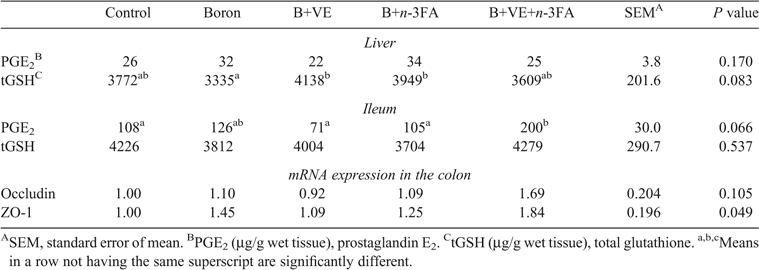Combined supplementation of boron, vitamin E and omega-3 fatty acids increases tight junction protein mRNA expression in the colon of E. coli-infected weaner pigs
J. C. Kim A C , K. L. Moore A , M. Trezona A , M. D. Langridge A , B. P. Mullan A and J. R. Pluske BA Department of Agriculture and Food, South Perth, WA 6151.
B Murdoch University, Murdoch, WA 6150.
C Corresponding author. Email: jae.kim@agric.wa.gov.au
Animal Production Science 55(12) 1542-1542 https://doi.org/10.1071/ANv55n12Ab089
Published: 11 November 2015
Enhancing intestinal barrier function and protection against epithelial cell damage in weaner pigs challenged by bacterial and (or) environmental stressors can improve health and growth efficiency. Among many nutrients boron (B), vitamin E (VE) and omega-3 fatty acids (n-3 FA) are known to reduce bacterial infection-induced responses through regulation of eicosanoid mediators and improved antioxidant capacity (Kim et al. 2013). This study tested the hypothesis that dietary supplementation with a combination of B, VE and n-3 FA will improve intestinal barrier function in weaned pigs infected with an enterotoxigenic strain of E. coli through down regulation of eicosanoid mediators and improved antioxidant capacity.
A total of 35 pigs (Large White × Landrace × Duroc) weaned at 21 ± 3 d of age and weighing 6.2 ± 0.05 kg (mean ± SE) was allocated to a completely randomised block design with five dietary treatments (n = 7): 1) Control; 15 MJ digestible energy (DE)/kg and 0.9 g standardised ileal digestible lysine/MJ DE, 2) B; Control + 7.5 ppm B (as boric acid), 3) B + VE; Control + B + 200 IU VE as dl-α-tocopheryl acetate, 4) B + n-3 FA; Control + B + 2% n-3 FA (as linseed oil), and 5) Control + B + VE + n-3 FA. Diets were fed ad libitum. Pigs were challenged with E. coli serotype O149:K91:K88 at d 7, 8 and 9 after weaning. Blood samples were collected before (d 7) and after (d 10) infection for cell counts, and all pigs were euthanised on d 10 to collect liver and intestinal tissue samples for analysis of tight junction protein gene expression (occludin and ZO-1) in the ileal and colonic epithelium using RT polymerase chain reaction (PCR). The concentrations of prostaglandin E2 (PGE2) and total glutathione (tGSH) were analysed using commercial ELISA kits. Data were analysed using one-way ANOVA (Genstat, 15th Edition; UK).
White blood cell counts showed that E. coli infection increased (P < 0.001) the numbers of leukocytes, lymphocytes, neutrophils and monocytes, indicating successful immune system activation. The concentration of tGSH in the liver tended to be increased (P = 0.083) in pigs fed the B + VE and B + n-3 FA diets compared with pigs fed the B diet. The concentration of PGE2 in the ileal epithelium tended to be increased (P = 0.066) in pigs fed the B + VE + n-3 FA diet compared with pigs fed the Control diet. The relative mRNA expressions of occludin (P = 0.105) and ZO-1 (P < 0.05) in the colonic epithelium were increased in pigs fed the B + VE + n-3 FA diet compared with pigs fed the Control diet (Table 1). The correlation study results indicated that increased mRNA expressions of selected tight junction proteins in the colonic epithelium of pigs fed the B + VE + n-3 FA diet were not associated with either in vivo biosynthesis of the eicosanoid mediator PGE2, or the production of the antioxidant tGSH.

|
References
Kim JC, Mullan BP, Pluske JR (2013) Australasian Pig Science Association Manipulating Pig Production, XIV, 62–76, eds JR Pluske and JM Pluske.This project was funded by Australian Pork Limited.


